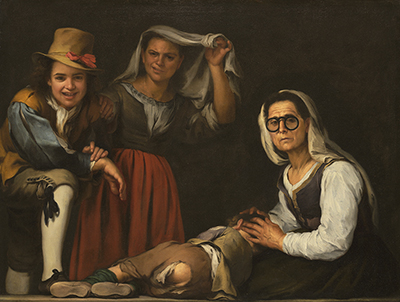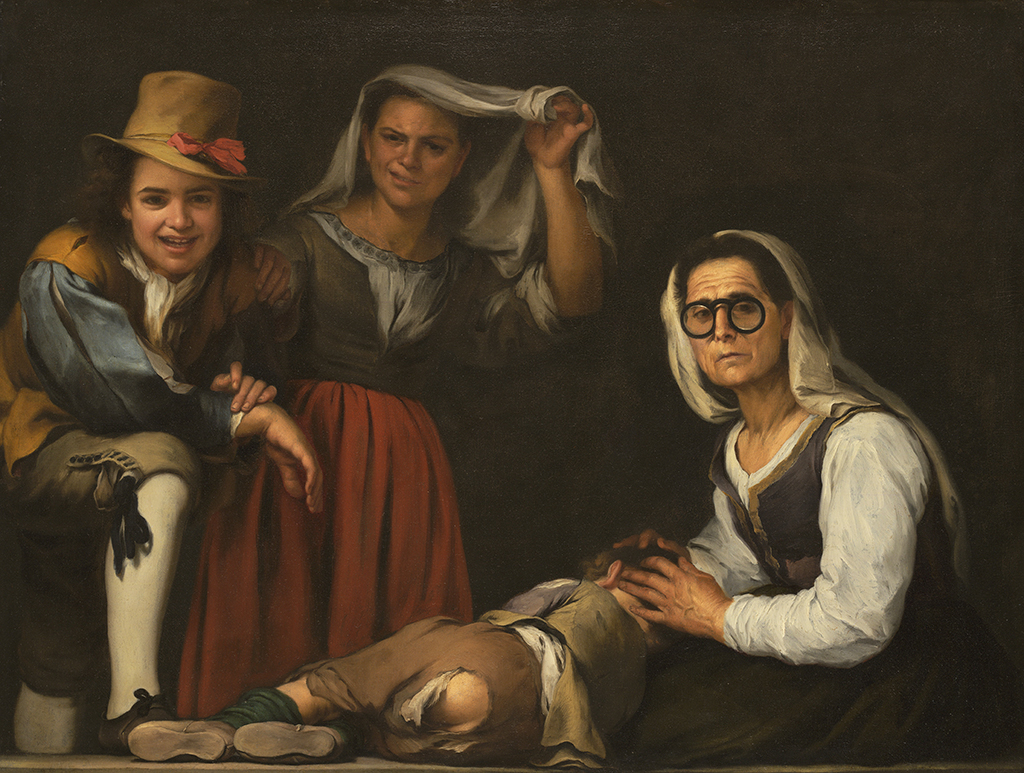This genre painting by Bartolomé Esteban Murillo is dated at around 1655–60. It captures the lives of local people within a fun and charming setting which was typical of this artist's work at that time.
We find four playful characters in front of us here, immediately pricking our interest in the goings-on placed in front of us. The painting itself is nearly one and a half metres wide, giving Murillo plenty of room for detail upon these portrait figures. One first sees the gentleman on the left hand side who sports a big smile, whilst leaning on his leg which is placed on a small ledge. A lady stands besides him, perhaps his partner, and she covers her hair with a white cloth whilst looking directly at us with a confused expression. An older woman is then sat down to the right, with a more concerned expression, no doubt dealing with the fourth person who lies across on the floor. The hole in their trousers is perhaps the cause for amusement, whilst others seem more worried about the health of the fallen individual. It seems that for some this is a normal occurrence, suggesting these people's lives are filled with challenge but also a comedic entertainment. Murillo would always be kind and fair when portraying local people in his work, whatever their background.
Murillo was particularly innovative and genre paintings had not really been seen in Spanish art previously, other than the occassional contribution as a side thought from the likes of Velazquez. By the 19th century Murillo's popularity had reduced substantially as his reputation was surpassed by the likes of Velazquez and El Greco, with tastes continue to change many times over the next few centuries. Today, they are all highly regarded and it is important to remember that even the likes of Botticelli have not always enjoyed the type of reputation that they do today. Murillo is rightly seen as an innovator who also brought about a real charm and sensitivity to his work which marked him out as somewhat unique within Spanish art. He also was able to fuse elements of different styles together successfully and had studied Flemish and Italian art from an early age.
This intriguing multi-figure portrait can now be found in the collection of the Kimbell Art Museum. It will normally be out on display, but has sometimes been loaned out elsewhere in order to be included amongst exhibitions of Murillo's paintings. They feature a good amount of information on this painting on their website and in various printed publications, including details of how they went about restoring elements of the piece, much of which was carried out relatively recently in the 1980s. Visitors to this establishment in Texas, USA, will be able to see a number of other notable artworks during their visit, such as the likes of Girls on the Pier by Edvard Munch, Portrait of Heriberto Casany by Joan Miro, On the Pont de l'Europe by Gustave Caillebotte and also Selim and Zuleika by Eugene Delacroix. The Kimbell has been growing in reputation in recent years and aims to expand its collection through a mixture of private acquisitions and generous donations. They host an excellent selection of sculpture, including works by the likes of Moore, Miro and Hepworth as well as paintings by the likes of Mondrian, Leger and Bonnard.





